Antarctica Penguins: Pictures, Facts and Information
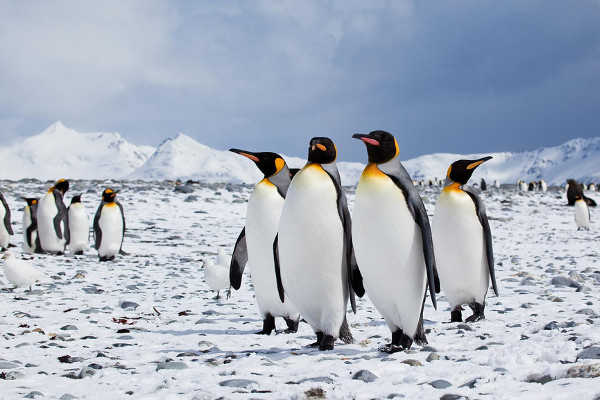
Considered by many to be the signature species of Antarctica, penguins are charismatic little creatures that win the heart of most tourists who visit the White Continent on an Antarctica cruise.
17 species of penguins are found worldwide, however, only 7 reside in the antarctic region and can be considered truly Antarctica penguins.
These are Adélies, Kings, Chinstraps, Emperors, Gentoos, Macaroni, and Rockhoppers.
Penguins are flightless birds, instead they’re designed to swim. Their powerful paddle muscles and sleek hydrodynamic shape makes them extremely quick in the water, often reaching speeds of 25 mph.
Although sharp, quick and elegant in the water, on-shore, penguins waddle and hop about in an awkwardly slow fashion.
Antarctica penguins are very well adapted to the cold. Their oily feathers, which gives penguins that distinguished well dressed look, do not allow water to pass through to their skin.
Underneath the outer feather layer is thick layer of fat which keep penguins so warm that they often need to fluff up their feathers to cool down.
Although Antarctica penguins have poor eyesight on land, their vision underwater is incredibly good. Like many Antarctica marine animals, penguins eyesight underwater picks up the green and blue hues of the sea exceptionally well.
Seals use their keen eyesight to catch prey and to avoid predators such as Leopard seals Killer whales.
Antarctica penguins generally feed on small fish and krill. It is easy to determine the diet of a particular penguin as penguins that eat krill excrete pink guano whilst penguins that consume fish have white guano.
Often, Antarctica penguins that have a krill diet will present red yolks in their eggs.
Penguins are very social creatures and their rookeries often exceed a million birds! With the exception of the Emperor penguin, most penguins like to congregate on beaches or rocky landscapes. You can often smell a rookery long before you see one!
Below we have provided information on each type of Antarctica penguin.
Get a Cruise Quote, Now!
Antarctica Guide do not sell tours, we simply provide impartial advice. If you would like an exact quote with our recommended specialist click Get a Quote.
Antarctica Penguins
Emperor Penguin
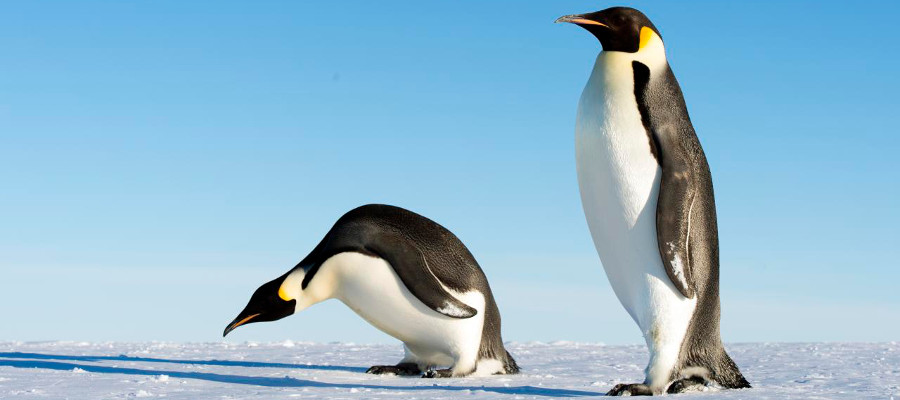
By far the most recognizable Antarctica penguin, Emperor penguins are the ‘classic’ type that everyone imagines when they think of a penguin.
They are the largest species of penguin on earth and often stand over a meter high. Their distinctive yellow colouring is something we are all familiar with and they seem to take no heed of humans if you get close.
Unlike other penguins, Emperor penguins have a very long breeding cycle, beginning in late March and continuing through to December. They breed in pairs and the males will look after the eggs whilst the females go in search of food for several months.
Also unlike other penguins, Emperor penguins head inland to breed, inhabiting the coldest land on earth. Males will stand for several months in tight bunches to keep their eggs warm, all the while balancing the eggs on their feet.
They endure temperatures of -100 degrees Celsius and winds off up to 200 kmph.
Immediately after the eggs hatch, females return to take care of the chick, giving the starving males a chance to hunt. Emperor penguins are possibly the only bird that does not set foot on land throughout their lives.
Sadly, most Antarctica cruises will not spot an Emperor penguin as they rarely inhabit the shoreline. If you’re very keen to see one then your best bet is the Weddell Sea Cruise. This particular Antarctica cruise takes helicopter rides specifically to scout out emperor penguins.
Emperor Penguin Facts
Size and weight: The average height of the Emperor penguin is 115 cm and the average weight is roughly 30 kg (65lb).
Feeding: They feed mainly on Antarctic fish, occasionally eating krill and squid.
Breeding Season: They breed in the winter months between late March and December when the average temperature is -25 degrees Celsius!
World Population: There are an estimated 600,000 Emperor penguins.
Distribution: Found only in Antarctica, usually inland.
Conservation Status: Stable, but classed as ‘Near Threatened’ due to climate change.
Predators: Killer whales and Leopard seals are their main predators. Seabirds such as Skuas will often eat chick eggs.
Chinstrap Penguins
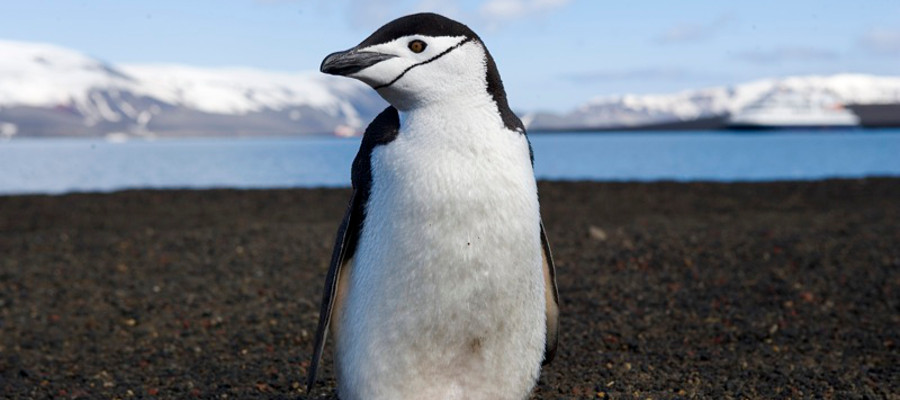
Deriving their name from the strap like line that circles from each eye down under their chin, Chinstrap penguins are one of noisiest and more aggressive penguins.
Fights among colonies break out fairly regularly and males will often kick out other males if they prefer a certain area. Males arrive on land first and will wait several day for their partner.
However, if she does not turn up, males will choose another female to mate with. If the previous partner does eventually show up, large fights ensue in which female penguins often chuck their opponents down hillsides.
Chinstrap penguins seem to prefer slightly warmer water as they only inhabit he outlying islands off the Antarctica Peninsula. A particularly good place to see them is on Deception Island where there is a colony of nearly a million!
Most Antarctica cruises will stop at Deception Island and you’ll have a good opportunity to see these noisy birds up close.
Chinstrap Penguins Facts
Size and weight: Chinstrap penguin average around 70 cm tall and usually weigh around 4.5 kg (10lb).
Feeding: They feed almost exclusively on krill and can dive up to 80 meters. They will eat fish occasionally, but only if krill is not available.
Breeding Season: The breeding season is between late November and March – the high summer.
World Population: There are at least 7.5 million Chinstrap penguins and colonies seem to be increasing.
Distribution: Chinstraps have a circumpolar distribution, usually on islands off the peninsula or in Southern South America. They have been found in New Zealand also.
Conservation Status: Protected by the Antarctic treaty, Chinstrap penguins have a conservation status of least concern.
Predators: Killer whales and Leopard seals are their main predators. Seabirds such as Skuas will often eat chick eggs.
Macaroni Penguin
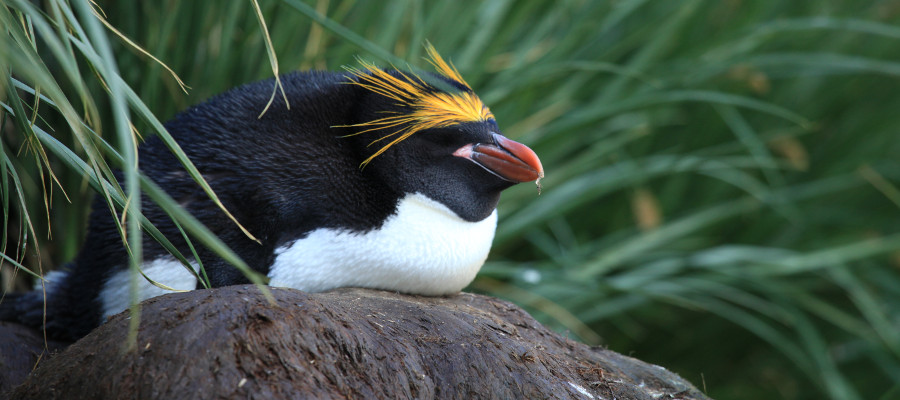
Macaroni penguins derive their name from their yellow plumage that can be seen above each eye.
The name Macaroni stems from the 18th century term ‘Macaroni Dandies’ which was a name given to people who dressed flamboyantly.
Similar in size to the Chinstrap penguin, Macaronis are not found on the Antarctic continent proper, instead they inhabit the warmer surrounding islands such as South Georgia and Heard Island.
Breeding season for Macaroni penguins is between December and January when their eggs are laid – hatching a month later. The female is usually the main hunter during this period until the chick reaches several weeks old whereby both parent leave to hunt daily.
Macaronis are exceptional swimmers and a recent study showed that they can swim up to 10,000 kilometers throughout the year. The male is slightly bigger and stronger than the female, bu the difference is minimal. Both have the same appearance.
Macaroni Penguin Facts
Size and weight: Roughly 70 cm tall and weigh about 4 kg (9lb).
Feeding: Macaroni’s feed mainly on Krill, but also eat fish when given the chance.
Breeding Season: Usually in December, Macaroni penguins usually spend less than a month ashore each year.
World Population: There an estimated 9 million breeding pairs! However, many colonies are in decline sadly.
Distribution: Most Macaroni penguins are found in the sub-Antarctic Islands like South Georgia. However, they have been found in New Zealand and Australia also.
Conservation Status: Protected by the Antarctic treaty, Macaroni penguins have a conservation status of least concern.
Predators: Killer whales and Leopard seals are their main predators. Seabirds like Skuas will regularly eat chick eggs.
Adelie Penguin
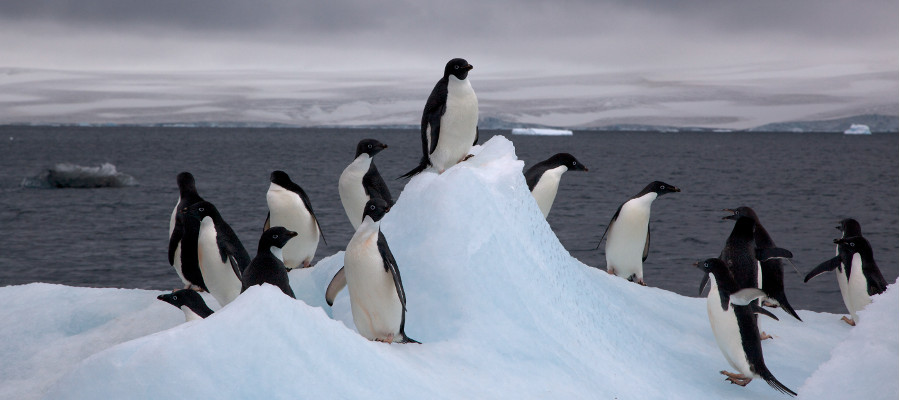
Along with Emperor penguins, Adelie penguins are the most southerly breeding penguin on earth. Named after the wife of French explorer Dumont d’Urville who discovered the penguins in 1840.
Adelie penguins are one of the smallest penguins in the Antarctic with an average height of 68 cm. Adelie colonies are loud and messy affairs. They can be heard and smelt long before they are seen.
During the winter the birds migrate to the outlying pack ice areas where temperatures are slightly warmer and in summer they migrate back towards the continent. Because of this, Adelie penguins often have to travel up to 100 km in the spring to find a nesting ground.
Males will arrive first at nesting sites and present females with gifts of pebbles when they arrive to attract their attention.
Strangely, mating pairs will often stay together for 5 or 6 years before separating. Parents will stay with their chicks for three weeks before they leave for the open water.
Adelie Penguin Facts
Size and weight: Adelie penguins are roughly 65-70 cm tall and weigh 5 kg (11 lb).
Feeding: They eat krill mostly but will also eat fish and small squid. Adelie penguins generally only dive to about 20 meters.
Breeding Season: Between November and February. Colonies are very large and noisy.
World Population: There is an estimated 5 million Adelie penguins. This number seems to be increasing.
Distribution: Adelie penguins have a circumpolar distribution. Generally are found on pack ice near the coast.
Conservation Status: Adelie penguins have recently been classed as ‘near threatened’ by the IUCN due to climate change.
Predators: Leopard seals are their main predators. Chicks are often preyed upon by Skuas.
Get a Cruise Quote, Now!
Antarctica Guide do not sell tours, we simply provide impartial advice. If you would like an exact quote with our recommended specialist click Get a Quote.
King Penguin
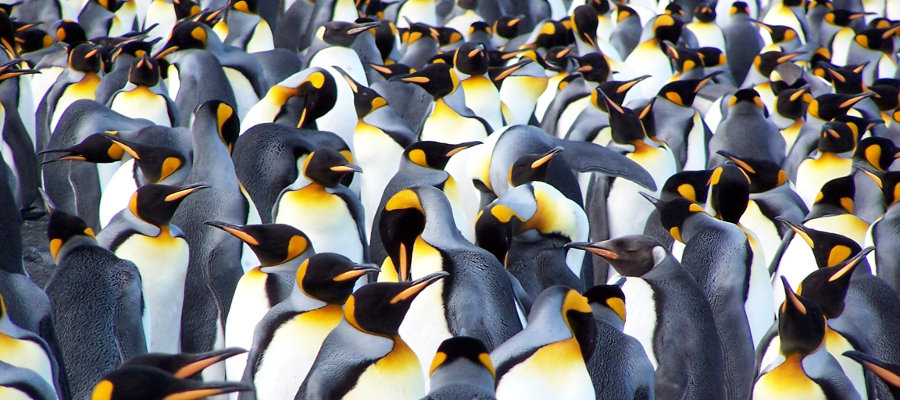
King penguins, along with Emperor penguins have become iconic among Antarctica tourists. Their large size and beautiful markings make them a favourite of many.
King penguins are the second biggest penguin species and the most brightly coloured. The prefer the warmer pars of the Antarctic and inhabit the sub-Antarctic islands such as South Georgia and the Macquarie Island.
Their colonies are often enormous and they can be seen on the beach all year-round, either as adults or chicks.
Unlike other penguins, King penguins have no nest to speak of. Instead, they carry their egg around the on their feet from area to area over a period of 50 – 60 days.
The egg is swapped by parents each week and the free parent will go in search of food during that period.
Chicks are often bigger than their parents when all fluffed up and can not enter the water until they have fully molted. Whilst their fluffy feathers are perfect for insulation, they are terrible in water.
Adult king penguins face the same problem once a year when their feather molt. During this period they have to live off fat reserves and stay ashore. The best Antarctica cruise to see King Penguins is on the Antarctica via Falklands and South Georgia cruise.
King Penguin facts
Size and weight: Just below a meter in height normally, they weigh roughly 15 kg (32 lb).
Feeding: Unusually, King penguins don’t really eat krill, instead, they mainly eat fish and squid.
Breeding Season: Depending on the colony and individual penguin, there are ‘early’ breeders and ‘late’ breeders. Early breeders breed between November and January and late breeders breed between January and March
World Population: There is an estimated 2 million breeding pairs, however, some estimations go as high as 3.2 million.
Distribution: Mainly on the sub-Antarctic islands such as South Georgia. Some colonies have been seen off the coast of Argentina also.
Conservation Status: Protected by the Antarctic treaty, King penguins have a conservation status of least concern.
Predators: Leopard seals are the King’s main predator. Skuas birds will prey on the chicks regularly.
Rockhopper Penguin
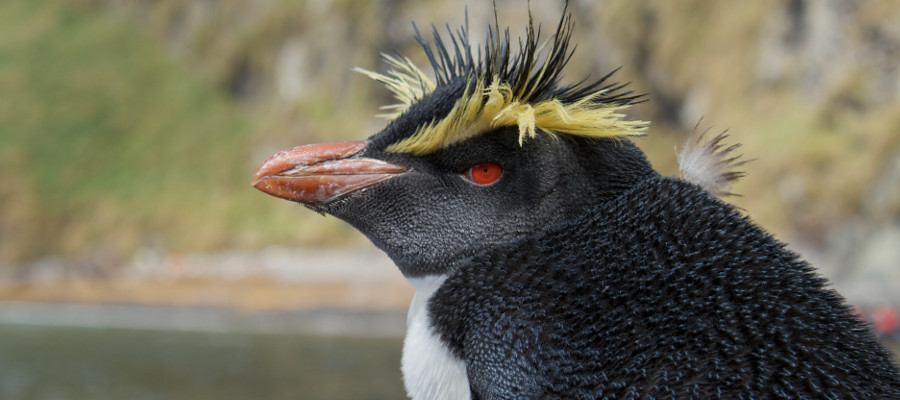
With an average height of just 55 cm, Rockhopper penguins are the smallest penguin species in the Antarctic region.
They are one of two species of crested penguins and their red eyes, orange beak and yellow line of plumage make them quite distinct.
Because Rockhopper penguins prefer rocky areas, they cannot slide on their bellies like other penguins, instead they must hop and jump everywhere.
There is an argument to suggest that Rockhopper penguins can be separated into three distinct species – Southern, Eastern and Northern, however, many researches disagree on this.
The Southern Rockhopper penguin is the species found in the Antarctic region and breeds on the Falklands Islands. Argentina and Chile are also good places to see them.
In the breeding season, Rockhopper penguins gather in large numbers along rocky and grassy shorelines. They like to build burrows in the long tussock grasses near shore and tend to return to the same beach and nest each year.
Rockhopper Penguin Facts
Size and weight: Rockhopper’s are the smallest types of penguin with an average height of 55 cm and weight of 2.5 kg (7 lb).
Feeding: Rockhopper’s mainly feed on krill but will also eat small fish, squid and crabs.
Breeding Season: December to March. Usually 2 eggs are laid and one will be smaller.
World Population: One of the most common penguins in the world with an estimated population of 9 million breeding pairs. Population is declining rapidly however, and scientists do not know why.
Distribution: Usually found in the sub-Antarctica Islands, particularly on Heard Island and South Georgia.
Conservation Status: Because of the rapid decline in population, Rockhopper penguins are now considered endangered.
Predators: Their main predators are Leopard seals and Fur seals. eggs are often eaten by Skuas and Kelp gulls.
Gentoo Penguin
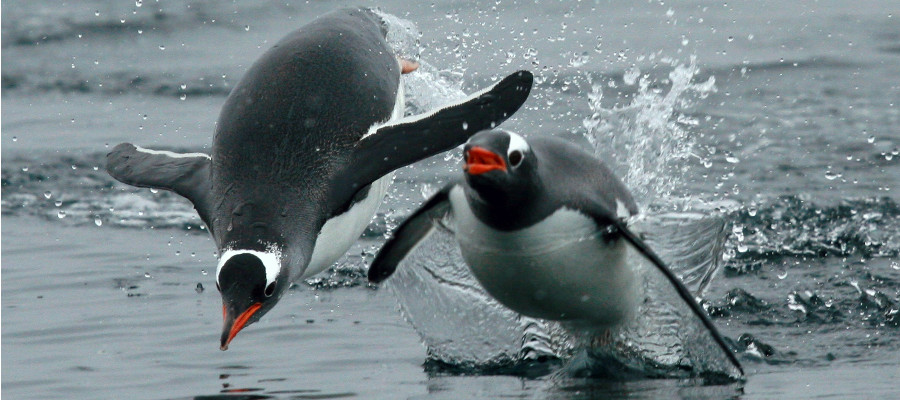
Gentoos are the most northerly living Antarctic penguin and tend to be less noisy and aggressive than other small penguin species. Compared to Chinstraps and Adelie’s, a colony of Gentoo’s are quite laid back!
Gentoo actually means ‘turban’ and refers to the white patch above the penguins eyes. Gentoos are found on many sub-Antarctic islands such as South Georgia, however, they also occupy beaches as far down as the peninsula.
Unlike other small penguin species, Gentoos will stay with their chosen mate all year-round.
Gentoo penguin will stay with their chick for around 8 weeks before heading to sea. If a pair lose their chick early on they will usually lay another egg.
During breeding season, Gentoo penguins will generally head inland slightly. However, to ease the burden of having to walk back and forth to the sea, Gentoo’s will all usually use the same path, which over time, wears the path down and makes it much easier to walk along.
Gentoo Penguin Facts
Size and weight: One of the taller penguin species with an average height of 70 cm and weight of 5 kg (12 lb).
Feeding: Gentoo penguins are opportunistic feeders and will eat krill, fish, crab and squid depending on what is to hand.
Breeding Season: December to March.
World Population: There is a rough estimate of about 385,000 breeding pairs.
Distribution: Most Gentoo penguins can be found in only 4 locations – the Falkland Islands, South Shetland Islands, South Georgia and the Antarctic Peninsula.
Conservation Status: Because scientists are unsure whether numbers are declining, the species is classified as ‘near threatened.
Predators: Killer whales and Leopard seals are their main predators. Skuas and Kelp gulls prey on the Gentoo eggs.
Get a Cruise Quote, Now!
Antarctica Guide do not sell tours, we simply provide impartial advice. If you would like an exact quote with our recommended specialist please complete the form.

Mark W
USA
FAQ
If you would like to know more about Antarctica penguins, please leave a comment below and we will endeavor to get back to you within 24 hours! Alternatively, please see our FAQ page here. If you would like to get a cruise quote, please use this form.
Thank you - AntarcticaGuide Team

Michio Takeda says
1 year ago
Going to see penguins in Antarctica in 2024.